Intel SSD DC P3700 Review: The PCIe SSD Transition Begins with NVMe
by Anand Lal Shimpi on June 3, 2014 2:00 AM EST- Posted in
- Storage
- SSDs
- Intel
- Intel SSD DC P3700
- NVMe
Random Read Performance
Although sequential performance is important, a true staple of any multi-user server is an IO load that appears highly random. For our small block random read test we first fill all drives sequentially, then perform one full drive write using a random 4K pass at a queue depth of 128. We then perform a 3 minute random read run at each queue depth, plotting bandwidth and latency along the way.
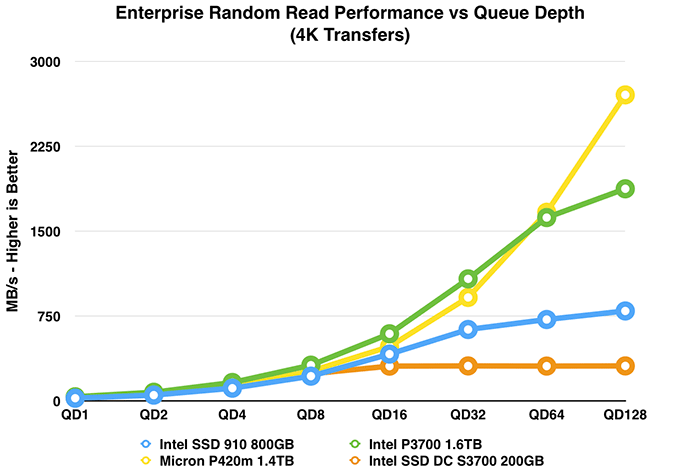
Small block random read operations have inherent limits when it comes to parallelism. In the case of all of the drives here, QD1 performance ends up around 20 - 40MB/s. The P3700 manages 36.5MB/s (~8900 IOPS) compared to 27.2MB/s (~6600 IOPS) for the SATA S3700. Even at a queue depth of 8 there's only a small advantage to the P3700 from a bandwidth perspective (~77000 IOPS vs. ~58400 IOPS). Performance does scale incredibly well with increasing queue depths though. By QD16 we see the P3700 pull away, at even as low as QD32 the P3700 delivers roughly 3.5x the performance of the S3700. There's a 70% advantage at QD32 compared to Intel's SSD 910, but that advantage grows to 135% at QD128.
Micron's P420m is incredibly competitive, substantially outperforming the P3700 at the highest queue depth.
Random read latency is incredibly important for applications where response time matters. Even more important for these applications is keeping latency below a certain threshold, what we're looking for here is a flat curve across all queue depths:
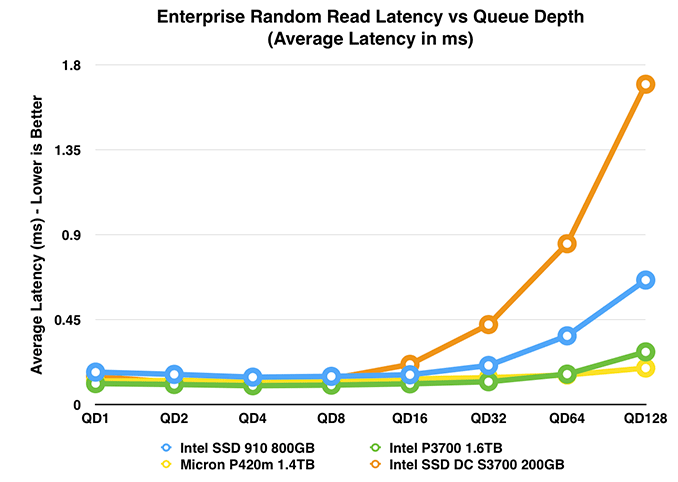
And that's almost exactly what the P3700 delivers. While the average latency for Intel's SSD DC S3700 (SATA) sky rockets after QD32, the P3700 remains mostly flat throughout the sweep. It's only at QD128 that we see a bit of an uptick. Even the 910 shows bigger jumps at higher queue depths.
If we remove the SATA drive and look exclusively at PCIe solutions, we get a better idea of the P3700's low latencies:
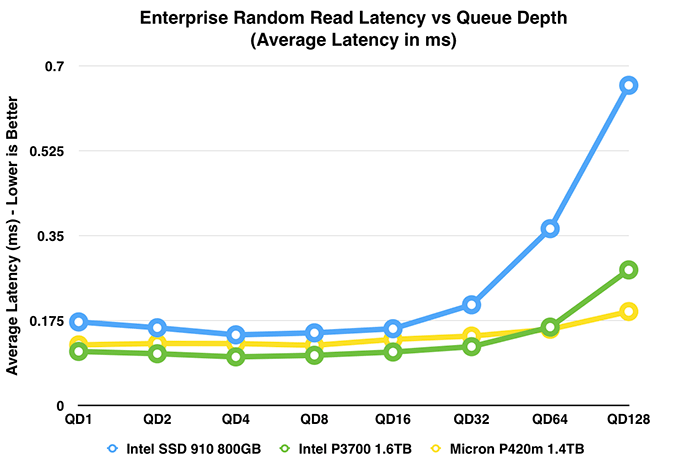
In this next chart we'll look at some specific numbers. Here we've got average latency (expressed in µs) for 4KB reads at a queue depth of 32. This is the same data as in the charts above, just formatted differently:
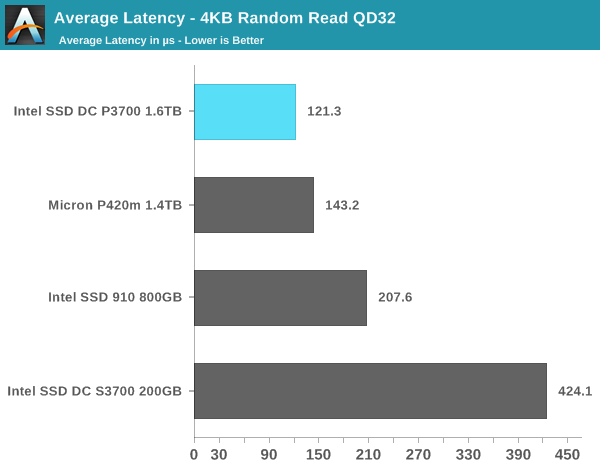
The P3700's latency advantage over its SATA counterpart is huge. Compared to other PCIe solutions, the P3700 is still leading but definitely not by as large of a margin. Micron's P420m comes fairly close.
Next up is average latency, but now at our highest tested queue depth: 128.
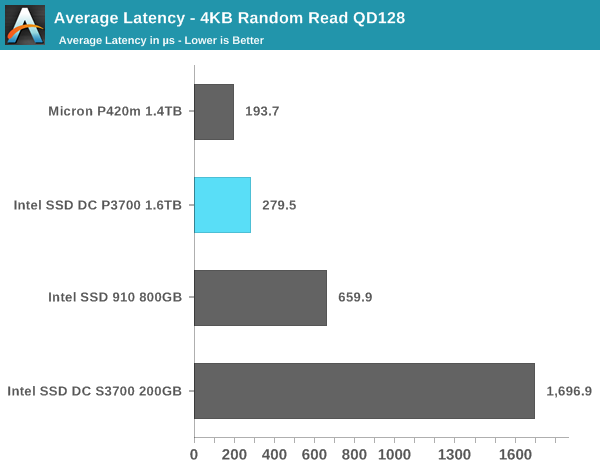
Micron's P420m definitely takes over here. Micron seems to have optimized the P420m for operation at higher queue depths while Intel focused the P3700 a bit lower. The SATA based S3700 is just laughable here, average completion latency is over 1.6ms.
Looking at maximum latency is interesting from a workload perspective, as well as from a drive architecture perspective. Latency sensitive workloads tend to have a max latency they can't exceed, but at the same time a high max latency but low average latency implies that the drive sees these max latencies infrequently. From an architectural perspective, consistent max latencies across the entire QD sweep give us insight into how the drive works at a lower level. It's during these max latency events that the drive's controller can schedule cleanup and defragmentation routines. I recorded max latency at each queue depth and presented an average of all max latencies across the QD sweet (From QD1 - QD128). In general, max latencies remained consistent across the sweep.
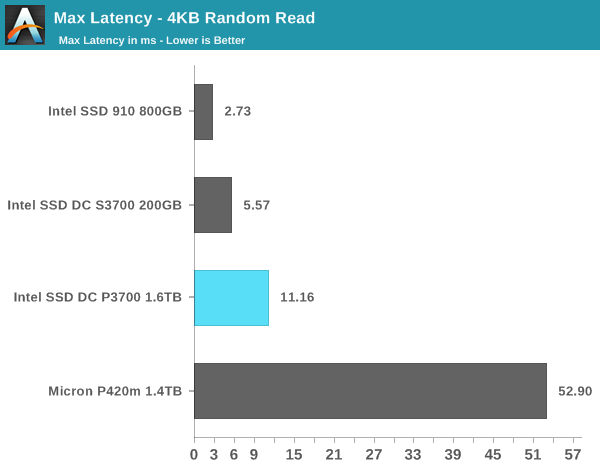
The 910's max latencies never really get out of hand. Part of the advantage is each of the 910's four controllers only ever see a queue depth of 32, so no individual controller is ever stressed all that much. The S3700 is next up with remarkably consistent performance here. The range of values the S3700 had was 2ms - 10ms, not correlating in any recognizable way to queue depth. Note the huge gap between max and average latency for the S3700 - it's an order of magnitude. These high latency events are fairly rare.
The P3700 sees two types of long latency events: one that takes around 3ms and another that takes around 15ms. The result is a higher max latency than the other two Intel drives, but with a lower average latency than both it's still fairly rare.
Micron's P420m runs the longest background task routine of anything here, averaging nearly 53ms. Whatever Micron is doing here, it seems consistent across all queue depths.
Random Write Performance
Now we get to the truly difficult workload: a steady state 4KB random write test. We first fill the drive to capacity, then perform a 4KB (QD128) random write workload until we fill the drive once more. We then run a 3 minute 4KB random write test across all queue depths, recording bandwidth and latency values. This gives us a good indication of steady state performance, which should be where the drives end up over days/weeks/months of continued use in a server.
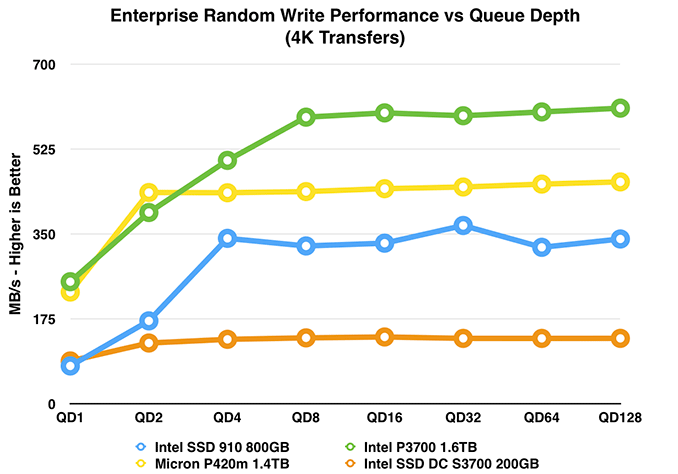
Despite the more strenuous workload, the P3700 absolutely shines here. We see peak performance attained at a queue depth of 8 and it's sustained throughout the rest of the range.
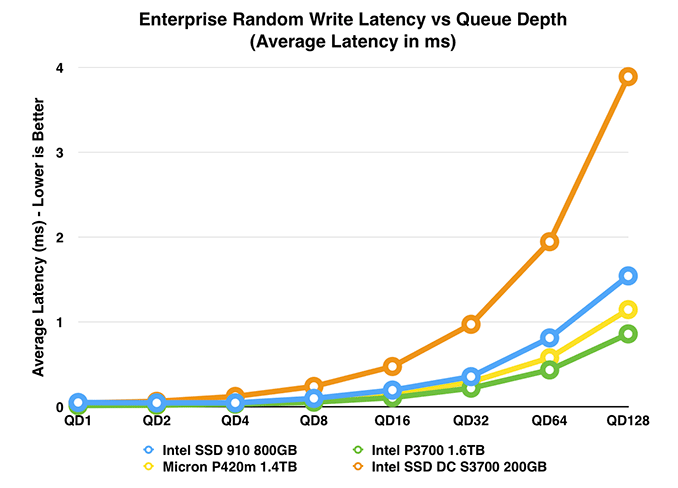
Average latency is also class leading - it's particularly impressive when you compare the P3700 to its SATA counterpart.
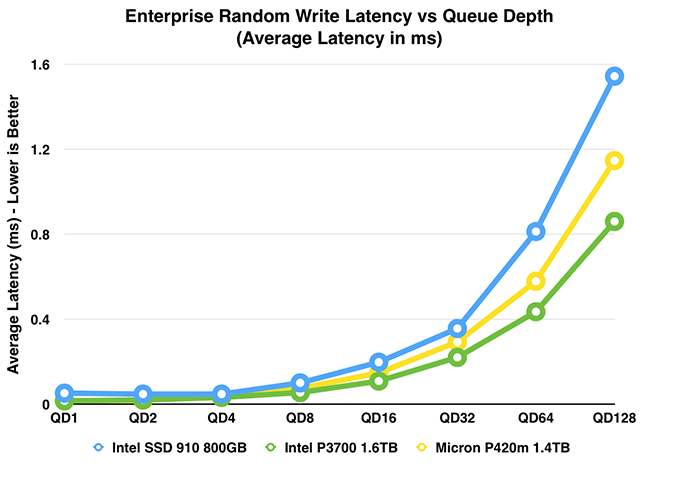
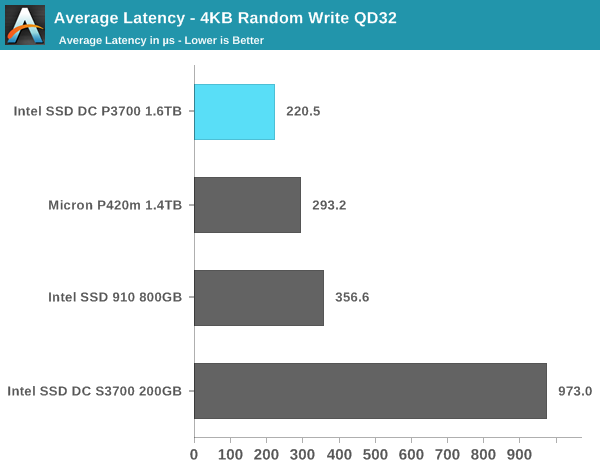

The absolute average latency numbers are particularly impressive. The P3700 at a queue depth of 128 can sustain 4KB random writes with IOs completing at 0.86ms.











85 Comments
View All Comments
gospadin - Tuesday, June 3, 2014 - link
tRead on MLC NAND is > 50us. 10us latency will never be achievable with an MLC NAND back-end without a redesign of the NAND array.mavere - Friday, June 6, 2014 - link
"I am angry because my ridiculous fantasies aren't fulfilled."Antronman - Tuesday, June 3, 2014 - link
Fusion iO blows it all away.TelstarTOS - Tuesday, June 3, 2014 - link
did they make it bootable on windows after what 8 years?extide - Tuesday, June 3, 2014 - link
At what cost?I'd definitely like to see some FusionIO benches on this site...
TelstarTOS - Tuesday, June 3, 2014 - link
At last Intel showed its muscles again.If in a 6 month timeframe something similar and cheaper doesnt come out, the 400GB P3600 will be my next SSD. Looking forward SF3700 really curiously now.
Kevin G - Tuesday, June 3, 2014 - link
I love the raw speed that this delivers. It does not hold anything back in terms of performance. I'm genuinely excited as to what a full blown server implementation using 16x PCIe 3.0 could provide.My only issue is one of capacity and cost per GB of storage. It is good to see 2 TB solutions but honestly I was hoping for a bit more. Moving away from the 2.5" SATA, M.2 and mSATA formats should enable far more NAND packages. I can see Intel limiting these consumer/prosumer cards to lower capacities to keep the higher capacity units in the enterprise space where ultra fast storage carries a higher premium. Speaking of costs, I was prepared to accept this as costing a bit more but not this much. Things like moving to an 18 channel design and the cost of the NVMe controller would be more expensive but not quiet this much. I was hoping to see something closer to $1/GB as the 2.5" SATA market is well below that and starting to approach $0.50/GB. Speed can carry a premium but those lower $/GB SATA drives are still pretty fast on their own.
Actually are there any subjective impressions? Does the P3700 feel noticeably faster in day-to-day usage than a generic 2.5" SATA SDD?
I'd also like to see some boot testing. Generally there are some quirks here and there that crop up with technology introductions.
kaix2 - Tuesday, June 3, 2014 - link
with the p3700 drive rated at 10dw/d it's aimed at high end enterprise. expecting $1/GB for this high end of a drive isn't realistic. also it's not a fair comparison if you simply compare the price of this drive to an average consumer sata drive and not take nand endurance and quality into account.Sacco_svd - Tuesday, June 3, 2014 - link
P3700 / 2048gb*3dollar = 6144 dollarsP3500 / 2048gb*1.469dollar = 3061.76 dollars
If those are going to be the prices they're still not competitively cheap, by a big margin.
balindad - Tuesday, June 3, 2014 - link
As mentioned else where, could you drop this in on any open pcie and have it work and bootable with no other upgrades needed as long as you're running windows 8?